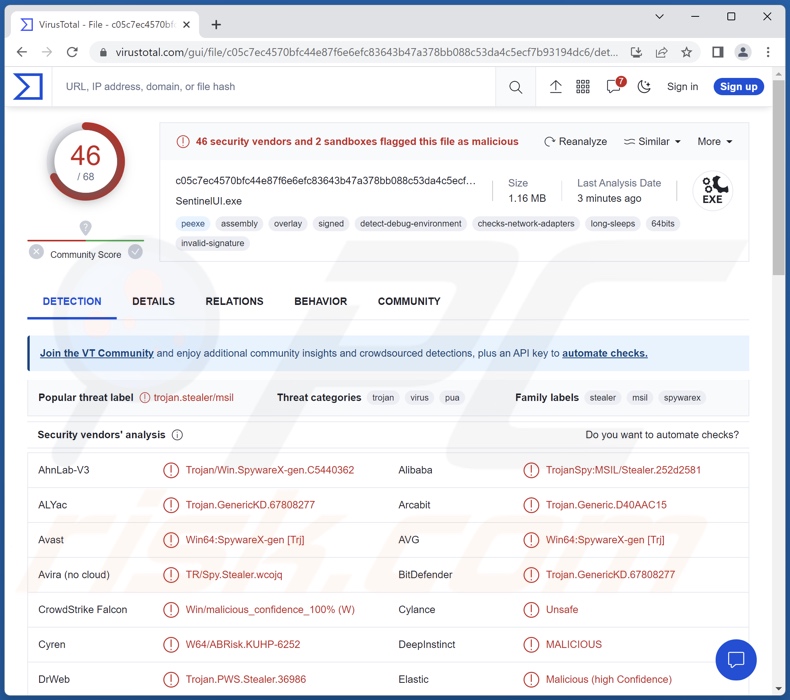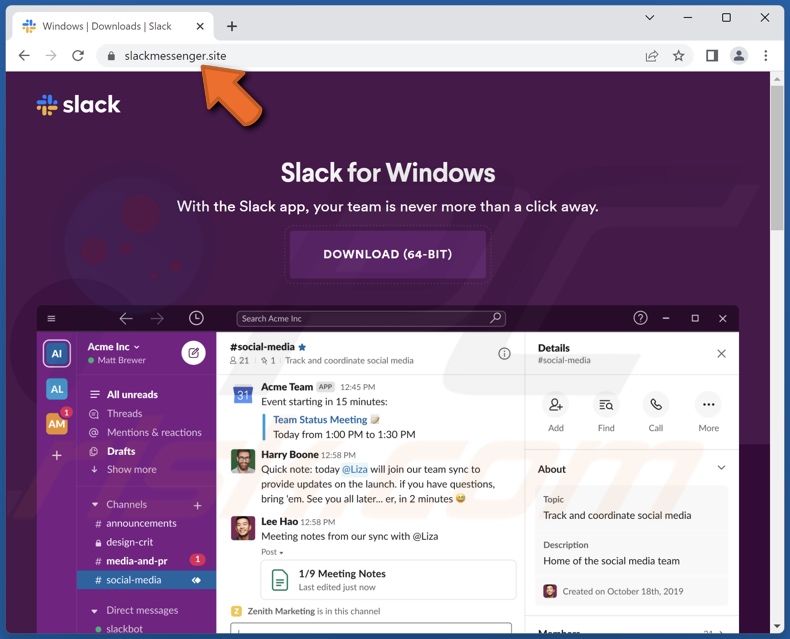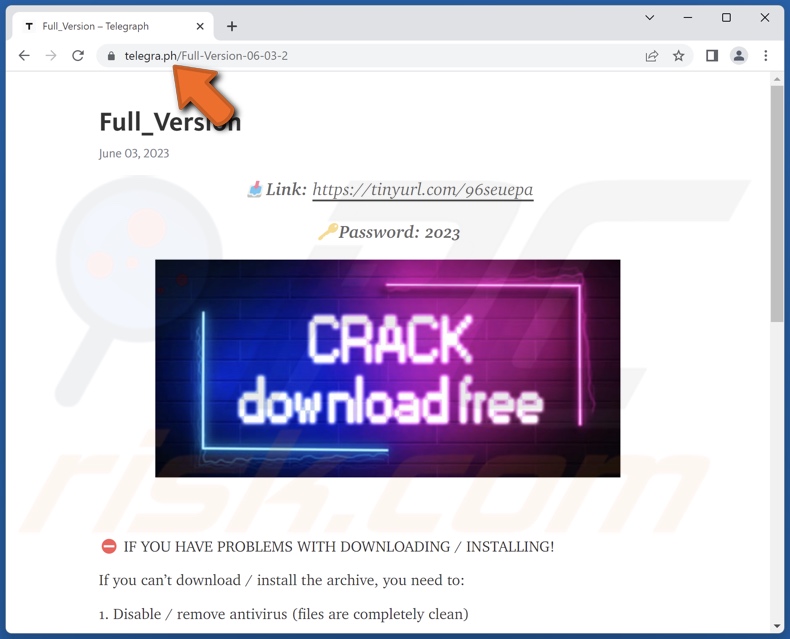Get free scan and check if your device is infected.
Remove it nowTo use full-featured product, you have to purchase a license for Combo Cleaner. Seven days free trial available. Combo Cleaner is owned and operated by RCS LT, the parent company of PCRisk.com.
What kind of malware is CustomerLoader?
CustomerLoader is a malicious program designed to cause chain infections. In other words, it loads additional malicious components and programs onto compromised devices. All known CustomerLoader infections relied on the DotRunpeX injector trojan to infiltrate the final payload. Over forty malware families were proliferated in this manner.
The cybersecurity community has first become aware of CustomerLoader's existence in June of 2023; however, there is some evidence suggesting that this malware has been active since at least May of the same year.
Due to the variety of distribution methods implemented for CustomerLoader, it is likely that the program's developers are offering it as a service – thus, the malware is used by multiple threat actors.

CustomerLoader malware overview
CustomerLoader employs several anti-detection and anti-analysis techniques. The program is disguised as a legitimate application and includes obfuscated code. It also employs tactics to bypass detection by anti-virus tools.
Following successful infiltration, CustomerLoader loads DotRunpeX. This injector-type malware likewise employs a variety of anti-detection techniques.
As previously mentioned, CustomerLoader campaigns (via DotRunpeX) have been observed being used for over forty malware families, such as various loaders, RATs (Remote Access Trojans), data stealers, and ransomware.
The final payloads include (but are not limited to): Amadey, LgoogLoader; Agent Tesla, AsyncRAT, BitRAT, NanoCore, njRat, Quasar, Remcos, Sectop, Warzone, XWorm; DarkCloud, Formbook, Kraken, Lumma, Raccoon, RedLine, Stealc, StormKitty, Vidar; WannaCry variants, Tzw ransomware, etc.
To summarize, high-risk malware infections can result in diminished system performance or failure, data loss, severe privacy issues, financial losses, and identity theft.
If you suspect that your device is infected with CustomerLoader (or any other malware) – immediately perform a full system scan with an anti-virus and remove all threats.
| Name | CustomerLoader virus |
| Threat Type | Trojan, Loader. |
| Detection Names | Avast (Win64:SpywareX-gen [Trj]), Combo Cleaner (Trojan.GenericKD.67808277), ESET-NOD32 (A Variant Of Generik.IGRGAQO), Kaspersky (HEUR:Trojan-Spy.MSIL.Stealer.gen), Microsoft (Trojan:Win32/Leonem), Full List Of Detections (VirusTotal) |
| Related Domains and VirusTotal Detections | slackmessenger[.]pw, slackmessenger[.]site, telegra[.]ph |
| Symptoms | Trojans are designed to stealthily infiltrate the victim's computer and remain silent, and thus no particular symptoms are clearly visible on an infected machine. |
| Distribution methods | Infected email attachments, malicious online advertisements, social engineering, software 'cracks'. |
| Damage | Stolen passwords and banking information, identity theft, the victim's computer added to a botnet. |
| Malware Removal (Windows) |
To eliminate possible malware infections, scan your computer with legitimate antivirus software. Our security researchers recommend using Combo Cleaner. Download Combo CleanerTo use full-featured product, you have to purchase a license for Combo Cleaner. 7 days free trial available. Combo Cleaner is owned and operated by RCS LT, the parent company of PCRisk.com. |
Loader-type malware examples
We have researched thousands of malware samples; Pikabot, Bumblebee, and GootLoader are just a few examples of loader-type programs.
Malicious software can be highly versatile and include various types of functionalities. The threats posed by an infection depend on the program's capabilities and the cyber criminals' goals. However, regardless of how malware operates or is used – its presence on a system endangers device and user safety. Therefore, all threats must be eliminated immediately upon detection.
How did CustomerLoader infiltrate my computer?
As mentioned in the introduction, CustomerLoader is most likely used by multiple threat actors. This loader has been noted being spread via malicious websites, YouTube videos, and phishing emails. In most of the known instances, the malware arrived onto systems as an executable in a ZIP archive.
To elaborate on the observed infection chains, over fifty domains have been connected to CustomerLoader. The deceptive sites claimed to host various video games, mouse plug-ins, VST (Virtual Studio Technology) plug-ins, conferencing/messaging software, and other content. After a victim selected a 'download' option on such a website, they were redirected to a malignant page hosting the malware.
For example, CustomerLoader has been distributed through a fake download webpage for the Slack instant messaging and video conferencing software; the final payload of this campaign was the RedLine stealer.
Over a hundred stolen YouTube accounts were utilized to promote download links for pirated programs. After clicking them, users were redirected to sites instructing how to disable their Microsoft Defender. Afterward, they downloaded a password-protected archive (supposedly containing the "cracked" software); this CustomerLoader chain culminated in a Raccoon stealer infection.
The detected spam emails were presented as a continuation of a nonexistent conversation. The letters included images of a PDF document that hid a hyperlink directing victims to the download of a ZIP archive containing CustomerLoader.
Due to the multitude of cyber criminals using CustomerLoader, it is certain that this program is proliferated using other methods as well.
Social engineering is standard in malware distribution, as is presenting malicious files under the guise of legitimate or innocent-looking software/media. Aside from executables and archives, infectious files can be documents (e.g., PDF, Microsoft Office, Microsoft OneNote, etc.), JavaScript, and others.
In general, malware is most widely spread via malicious attachments and links in spam mail (e.g., emails, PMs/DMs, SMSes, etc.), online scams, malvertising, drive-by (stealthy/deceptive) downloads, pirated programs, illegal software activation ("cracking") tools, and fake updates. What is more, some malicious programs can self-spread via local networks and removable storage devices (e.g., external hard drives, USB flash drives, etc.).
How to avoid installation of malware?
We strongly recommend being careful while browsing since fake and malicious content usually appears legitimate and innocuous. Additionally, incoming emails and messages must be treated with caution. We advise against opening attachments or links found in suspicious mail, as they can be malicious.
Another recommendation is to download only from official and verified channels. It is just as important to activate and update software using legitimate functions/tools, as those acquired from third-parties may contain malware.
We must emphasize that having a reputable anti-virus installed and kept up-to-date is paramount to device/user safety. Security programs must be used to run regular system scans and to remove detected threats and issues. If you believe that your computer is already infected, we recommend running a scan with Combo Cleaner Antivirus for Windows to automatically eliminate infiltrated malware.
CustomerLoader malware promoted on a fake Slack software download website:

CustomerLoader malware promoted on a fake "cracked" software download website:

Instant automatic malware removal:
Manual threat removal might be a lengthy and complicated process that requires advanced IT skills. Combo Cleaner is a professional automatic malware removal tool that is recommended to get rid of malware. Download it by clicking the button below:
DOWNLOAD Combo CleanerBy downloading any software listed on this website you agree to our Privacy Policy and Terms of Use. To use full-featured product, you have to purchase a license for Combo Cleaner. 7 days free trial available. Combo Cleaner is owned and operated by RCS LT, the parent company of PCRisk.com.
Quick menu:
- What is CustomerLoader?
- STEP 1. Manual removal of CustomerLoader malware.
- STEP 2. Check if your computer is clean.
How to remove malware manually?
Manual malware removal is a complicated task - usually it is best to allow antivirus or anti-malware programs to do this automatically. To remove this malware we recommend using Combo Cleaner Antivirus for Windows.
If you wish to remove malware manually, the first step is to identify the name of the malware that you are trying to remove. Here is an example of a suspicious program running on a user's computer:

If you checked the list of programs running on your computer, for example, using task manager, and identified a program that looks suspicious, you should continue with these steps:
 Download a program called Autoruns. This program shows auto-start applications, Registry, and file system locations:
Download a program called Autoruns. This program shows auto-start applications, Registry, and file system locations:

 Restart your computer into Safe Mode:
Restart your computer into Safe Mode:
Windows XP and Windows 7 users: Start your computer in Safe Mode. Click Start, click Shut Down, click Restart, click OK. During your computer start process, press the F8 key on your keyboard multiple times until you see the Windows Advanced Option menu, and then select Safe Mode with Networking from the list.

Video showing how to start Windows 7 in "Safe Mode with Networking":
Windows 8 users: Start Windows 8 is Safe Mode with Networking - Go to Windows 8 Start Screen, type Advanced, in the search results select Settings. Click Advanced startup options, in the opened "General PC Settings" window, select Advanced startup.
Click the "Restart now" button. Your computer will now restart into the "Advanced Startup options menu". Click the "Troubleshoot" button, and then click the "Advanced options" button. In the advanced option screen, click "Startup settings".
Click the "Restart" button. Your PC will restart into the Startup Settings screen. Press F5 to boot in Safe Mode with Networking.

Video showing how to start Windows 8 in "Safe Mode with Networking":
Windows 10 users: Click the Windows logo and select the Power icon. In the opened menu click "Restart" while holding "Shift" button on your keyboard. In the "choose an option" window click on the "Troubleshoot", next select "Advanced options".
In the advanced options menu select "Startup Settings" and click on the "Restart" button. In the following window you should click the "F5" button on your keyboard. This will restart your operating system in safe mode with networking.

Video showing how to start Windows 10 in "Safe Mode with Networking":
 Extract the downloaded archive and run the Autoruns.exe file.
Extract the downloaded archive and run the Autoruns.exe file.

 In the Autoruns application, click "Options" at the top and uncheck "Hide Empty Locations" and "Hide Windows Entries" options. After this procedure, click the "Refresh" icon.
In the Autoruns application, click "Options" at the top and uncheck "Hide Empty Locations" and "Hide Windows Entries" options. After this procedure, click the "Refresh" icon.

 Check the list provided by the Autoruns application and locate the malware file that you want to eliminate.
Check the list provided by the Autoruns application and locate the malware file that you want to eliminate.
You should write down its full path and name. Note that some malware hides process names under legitimate Windows process names. At this stage, it is very important to avoid removing system files. After you locate the suspicious program you wish to remove, right click your mouse over its name and choose "Delete".

After removing the malware through the Autoruns application (this ensures that the malware will not run automatically on the next system startup), you should search for the malware name on your computer. Be sure to enable hidden files and folders before proceeding. If you find the filename of the malware, be sure to remove it.

Reboot your computer in normal mode. Following these steps should remove any malware from your computer. Note that manual threat removal requires advanced computer skills. If you do not have these skills, leave malware removal to antivirus and anti-malware programs.
These steps might not work with advanced malware infections. As always it is best to prevent infection than try to remove malware later. To keep your computer safe, install the latest operating system updates and use antivirus software. To be sure your computer is free of malware infections, we recommend scanning it with Combo Cleaner Antivirus for Windows.
Frequently Asked Questions (FAQ)
My computer is infected with CustomerLoader malware, should I format my storage device to get rid of it?
Most malicious programs can be removed without resorting to formatting.
What are the biggest issues that CustomerLoader malware can cause?
The threats posed by a program depend on its functionalities and the cyber criminals' goals. In the case of CustomerLoader, the exact threats are difficult to pinpoint since this program is designed to infect systems with other malware, and multiple threat actors use it. In general, high-end infections can lead to diminished system performance or failure, data loss, severe privacy issues, financial losses, and identity theft.
What is the purpose of CustomerLoader malware?
In most cases, malware is used for profit. However, cyber criminals can also utilize malicious software to amuse themselves, carry out personal vendettas, disrupt processes (e.g., sites, services, companies, etc.), and even launch politically/geopolitically motivated attacks.
How did CustomerLoader malware infiltrate my computer?
CustomerLoader has been observed being distributed via phishing emails, malicious websites, and links promoted on stolen YouTube accounts. However, it is likely proliferated using other methods as well.
The most widely used techniques include: drive-by downloads, online scams, spam emails and messages, malvertising, dubious download sources (e.g., freeware and third-party websites, P2P sharing networks, etc.), illegal program activation tools ("cracks"), and fake updates. Furthermore, some malicious programs can self-spread through local networks and removable storage devices.
Will Combo Cleaner protect me from malware?
Yes, Combo Cleaner is capable of detecting and eliminating practically all known malware infections. It must be stressed that since high-end malicious software usually hides deep within systems – running a full system scan is crucial.
Share:

Tomas Meskauskas
Expert security researcher, professional malware analyst
I am passionate about computer security and technology. I have an experience of over 10 years working in various companies related to computer technical issue solving and Internet security. I have been working as an author and editor for pcrisk.com since 2010. Follow me on Twitter and LinkedIn to stay informed about the latest online security threats.
PCrisk security portal is brought by a company RCS LT.
Joined forces of security researchers help educate computer users about the latest online security threats. More information about the company RCS LT.
Our malware removal guides are free. However, if you want to support us you can send us a donation.
DonatePCrisk security portal is brought by a company RCS LT.
Joined forces of security researchers help educate computer users about the latest online security threats. More information about the company RCS LT.
Our malware removal guides are free. However, if you want to support us you can send us a donation.
Donate
▼ Show Discussion